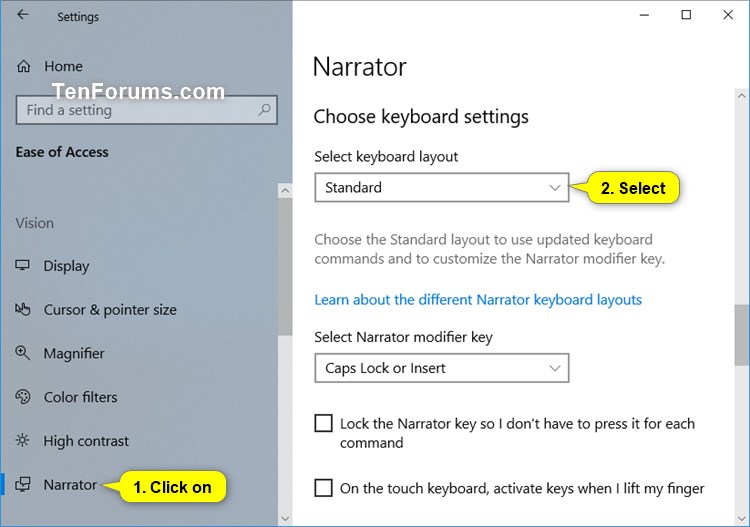How to Change Narrator Keyboard Layout in Windows 10
Narrator is a screen-reading app built into Windows 10.
Narrator lets you use your PC without a display or mouse to complete common tasks if you’re blind or have low vision. It reads and interacts with things on the screen, like text and buttons. Use Narrator to read and write email, browse the internet, and work with documents.
Specific commands let you navigate Windows, the web, and apps, as well as get info about the area of the PC you're in. Navigation is available using headings, links, landmarks, and more. You can read text (including punctuation) by page, paragraph, line, word, and character as well as determine characteristics like font and text color. Efficiently review tables with row and column navigation.
Narrator also has a navigation and reading mode called Scan Mode. Use it to get around Windows 10 using just the up and down arrows on your keyboard. You can also use a braille display to navigate your PC and read text.
Finally, you can personalize Narrator's voice to adjust the speaking rate, pitch, and volume as well as install some third-party text-to-speech voices.
Starting with Windows 10 build 17692, there is a new Standard keyboard layout for Narrator that is designed to be more familiar to screen reader users. The Standard keyboard layout is more like the keyboard layout you may have experienced in other screen readers.
You can explore all the new and updated commands in Appendix B: Narrator keyboard commands and touch gestures. Find scan mode commands in Chapter 3: Using scan mode. When keyboard commands are mentioned in this guide, they’re for the new standard keyboard layout. Some of the new commands include updates to Narrator’s page, paragraph, line, word, and character commands. You’ll also notice new commands like Narrator Find, list of links, list of headings, and list of landmarks. For some commands, you can now use the numeric keypad.
Your keyboard will default to the Standard layout. If you want to change this, choose the Legacy layout. New Narrator commands will not be available in the Legacy keyboard layout if keystrokes for legacy commands conflict with those used in new Narrator features.
For more details about the new Standard keyboard layout for Narrator, see:
This tutorial will show you how to change the Narrator keyboard layout to Standard or Legacy for your account in Windows 10.
- Option One: Change Narrator Keyboard Layout in Settings
- Option Two: Change Narrator Keyboard Layout using a REG file
1. Open Settings, and click/tap on the Ease of Access icon.
You can press the Win+Ctrl+N keys to directly open to Narrator settings.
2. Click/tap on Narrator on the left side, and select Standard (default) or Legacy in the Select keyboard layout drop menu for what you want on the right side under the Choose keyboard settings section. (see screenshots below)
You will only be able to change the Narrator modifier key if you have selected the Standard keyboard layout.
3. You can now close Settings if you like.

The downloadable .reg files below will modify the DWORD value in the registry key below.
HKEY_CURRENT_USER\Software\Microsoft\Narrator
KeyboardLayout DWORD
0 = Legacy
1 = Standard
1. Do step 2 (Standard) or step 3 (Legacy) below for what you would like to do.
This is the default setting.
A) Click/tap on the Download button below to download the file below, and go to step 4 below.
Use_Standard_keyboard_layout_for_Narrator.reg
Download
A) Click/tap on the Download button below to download the file below, and go to step 4 below.
Use_Legacy_keyboard_layout_for_Narrator.reg
Download
4. Save the .reg file to your desktop.
5. Double click/tap on the downloaded .reg file to merge it.
6. When prompted, click/tap on Run, Yes (UAC), Yes, and OK to approve the merge.
7. You can now delete the downloaded .reg file if you like.
That's it,
Shawn
Related Tutorials
- How to Turn On or Off Narrator in Windows 10
- How to Turn On or Off and Use Narrator Scan Mode in Windows 10
- How Turn On or Off Automatically Start Narrator after Sign-in in Windows 10
- How Turn On or Off Automatically Start Narrator before Sign-in in Windows 10
- How to Enable or Disable Win+Ctrl+Enter Shortcut Key to Turn Narrator On or Off in Windows 10
- How to Select Audio Channel for Narrator Speech Output in Windows 10
- How to Turn On or Off Showing Narrator Keyboard Changes at Narrator Startup in Windows 10
- How to Turn On or Off Show Narrator Home when Narrator Starts in Windows 10
- How to Change Minimize Narrator Home to Taskbar or System Tray in Windows 10
- How to Customize Narrator Voice in Windows 10
- How to Customize Narrator Cursor Settings in Windows 10
- How to Turn On or Off Send Diagnostic Data about Narrator in Windows 10
- How to Read by Sentence in Narrator in Windows 10
- How to Change Keyboard Shortcuts for Narrator Commands in Windows 10
- How to Turn On or Off Narrator Auto Read Advanced Info about Controls in Windows 10
- How to Turn On or Off Online Services for Narrator in Windows 10
- How to Change Narrator Modifier Key in Windows 10
- How to Turn On or Off Lock the Narrator Key in Windows 10
- How to Turn On or Off Activate Keys on Touch Keyboard when Lift Finger for Narrator in Windows 10
Change Narrator Keyboard Layout in Windows 10

Change Narrator Keyboard Layout in Windows 10
How to Change Narrator Keyboard Layout in Windows 10Published by Shawn BrinkCategory: Apps & Features
14 Jun 2019
Tutorial Categories


Related Discussions



